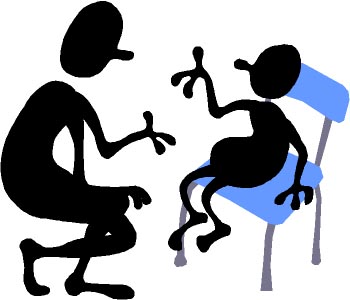AFTER
A YOUNGSTER HAS BEEN VIOLENT 
(After
s/he has "cooled down") 1. I DEBRIEF HIM/HER:
-"Why were
you willing to:
-hurt another?"
-fight?"
-"What
was your purpose in that situation?"
-"How
else could you have attained that goal?"
2. I ASSIST IN THE "FUNCTIONAL
BEHAVIOR ASSESSMENT":
-Where and when did it happen?
-Who was present?
-What event(s) preceded the action?
-What behavioral signals did the
youngster show before the outburst?
-What actions were taken to prevent
the crisis & were they effective?
-What factors influenced/supported
this behavior?

-
-Lack of:
-social skills
-anger control
-staff supervision
-Absence of effective school
penalties
-Absence of a school action
plan
-Lack of staff training in:
-recognizing and defusing escalating situations
-relating with kids in a positive, non-bossy/non-wimpy manner
-behavior management
3. I HELP THE IEP/SCHOOL-BASED
SUPPORT TEAM:
- IDENTIFY BEHAVIORAL IDIOSYNCRASIES & PATTERNS
-DEVISE A PLAN FOR DEALING WITH THEM:
-I teach better ways via instruction in:
-social skills
-anger management
-conflict resolution
-value re-orientation
-We devise a plan to help the youngster
attain desired goals while avoiding conflict
-I engage him/her in role playing
of the plan
-I instigate spontaneous "tests"
of the youngster's ability to use the new actions
-I continue the program until the
appropriate actions are "automatic"
-I involve others in supporting
the youngster
-peers
-favorite teachers/para professionals/teacher aides
-janitor
-bus driver
-parents
-security guards
-school social worker
-guidance counselor
4. I WORK TO STRENGTHEN MY (and
others') BONDS WITH THE
YOUNGSTER
(and all kids)
It was after the Napoleonic wars that Johann Pestolozzi suggested that
the highest pedagogical skill was to be able to confront unacceptable behavior
while at the same time building positive bonds with the offender.
Tips
for Handling Aggression in Younger Kids
(and those who will listen to you)
1. For younger kids, say: "There is no
hitting in our room. You have to leave." Send him/her to time
out. Upon return ask: "What is our rule?" (Use words or get a teacher.
No hitting)
2. If you catch kids in mid-argument, tell
them to talk it out and come up with a solution. They are to tell
you what the solution is.
AN
ACTIVITY
THE SITUATION:
I noticed a distraught/upset student (who
I knew well from last year) as s/he ran into the bathroom.
I approached the rest room doorway and
entered. The two of us were the only ones in the lavatory.
S/he yelled "Stay
away from me or you'll be eating tile" (I'd be thrown down to the
floor). This student has a reputation for being explosive and sometimes
violent, but the two of us have had a friendly and cordial relationship
(with some periodic strife).
At that point I realized that a few other
students were gathering outside the doorway to watch what was happening
(the door was propped open with a wooden wedge).
***Describe
what you thought about or actually did before entering the bathroom, and
what you did in this situation to defuse the emotionally charged pupil.
Web
Based Resources
www.antibullying.net
provides many techniques for handling and reducing bullying
www.bullying.co.uk
provides a vast array of ideas and information regarding bullying
http://www.bullybeware.com/moreinfo.html
Information
on bullying and what can be done.
For a great number of articles on violence
and it's prevention in our schools, log onto: www.ericfacility.net
and type "aggression" into the search box.
United States Department of Educaton. (1998).
Early
warning, timely response: A guide to safe schools. Available free of
charge from the U.S. Dept. of Education, 400 Maryland Avenue SW, Washington,
DC 20202 or through the web site at http://www.ed.gov/offices/OSERS/OSEP/earlywrn.html
or
http://cecp.air.org/guide
or
e-mail: David_Summers@ed.gov
or
telephone at 202/205-9043
United States Department of Education.
(2000). Safeguarding our children: An action guide.
Available free of charge from the U.S. Dept. of Education, 400 Maryland
Avenue SW, Washington, DC 20202
or through the web site at
http://www.ed.gov/orhttp://cecp.air.org/guideor
order the guide through the web site for the Center for Effective Collaboration
and Practice. Their web site link is posted on the home page of this
site (www.BehaviorAdvisor.com)
under the title "Other web sites".
Comedian Mike Pritchard presents funny,
but informative and effective presentations to students about acceptance
of others, opposing ridicule and violence, etc. Contact him or order
his videos at http://www.livewiremedia.com/poc.html
For more information and links to many
sites related to aggressive behavior, log onto the following sites:
http://www.air.org/cecp/guide/websites.htm
www.kidsource.com/kidsource/content2/aggression_and_coop.html
www.aboutourkids.org/aboutour/articles/aggression.html
www.earlychildhoodbehavioralhealth.com/Articles/Aggression.htm

Suggested
Readings
Violence prevention: What every parent
should know. (video)
Available
at www.researchpress.com
Violence prevention: What middle
school teachers and students should know. (video) Available
at www.researchpress.com
Molly Bang (19**). When Sophie Gets
Angry - Really, Really Angry.
Allan Beane (19**). The bully free
classroom: over 100 tips and strategies for teachers K-8.
Available from Free Spirit Publishing
at 1-800-735-7323.
Nancy Carlsson-Paige & Diane Levin
(1998). Before push comes to shove: Building conflict resolution
skills with children. Redleaf Press Call
1-800-370-2515 or log onto
www.esrnational.org
Canter & Garrison (1999). Preventing
conflict and violence in your classroom: Scared or prepared? Santa
Monica, CA: Canter & Associates. Call 1-800-262-4347.
Allan Creighton (1992). Helping teens
stop violence: A practical guide for counselors, educators, and parents.
Hunter House, Inc.
Call 1-800-370-2515 or log onto
www.esrnational.org
Leona Eggert (19**). Anger management
for youth: Stemming aggression and violence. (grades 9-12) From
National Educational Service at 800/733-6786 or www.nesonline.com
Arnold Goldstein. Low-level aggression:
First steps on the ladder to violence. Available
at www.researchpress.com
Goldstein, Glick, & Gibbs. Aggression
replacement training: A comprehensive intervention for aggressive youth.
Available at www.researchpress.com
Arnold Goldstein, Berj Harootunian, &
Jane Conoley. (1994). Student aggression: Prevention, management,
and replacement training. New York: Guilford
Goldstein, Palumbo, Striepling, & Voutsinas.
Break
it up: A teacher's guide to managing student aggression.
Available
at www.researchpress.com
Goldstein, Palumbo, & Striepling.
Break
it up: Managing student fights. (video) Available
at www.researchpress.com
Hammond & Gipson. Dealing with
anger: A violence prevention program for African American youth.
(video) Available at www.researchpress.com
Hammond & Gipson.
PACT: Postive Adolescent Choices Training: A model for violence
prevention groups with African American youth. (video) Available
at www.researchpress.com
Terry Hyland & Jerry Davis. Angry kids,
frustrated parents. Call 1-800-282-6657
or log onto www.boystown.org/btpress
Beverly Johns (1997). Techiques for
managing a safe school. Denver: Love Publishing
Beverly Johns & Valerie Carr (1995).
Techniques
for managing verbally and physically
aggressive students.
Denver: Love Publishing.
Kathy Noll and Jay Carter (2000). Taking
the bully by the horns(book and videos).
Log onto: http://kathynoll.com
Deborah Prothrow-Stith (1987). Violence
prevention curriculum for adolescents. Newton, MA: Education Development
Center. Call 617-969-7100
Michael Sterba & Jerry Davis. Dangerous
kids: Boys Town's approch for helping caregivers treat aggressive and violent
youth.Call 1-800-282-6657 or
log onto www.boystown.org/btpress
"The Child's Work,
Child's Play" Company has a large number of resources for helping kids
deal with bully's and aggressive kids.
Call 1-800-962-1141 for a catalog
Videos for anger management and anti-bullying
training for kids can be found at www.sunburstvm.com (800-4311934)

So Pup,
what caused you to rip up the home page?
Revised 11/09/04 (New links
added)
Author: Tom McIntyre at
www.BehaviorAdvisor.com

![]()
 & I FEAR ATTACK:
& I FEAR ATTACK:



